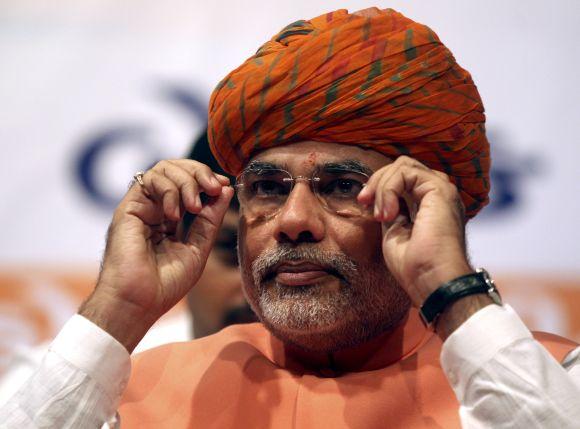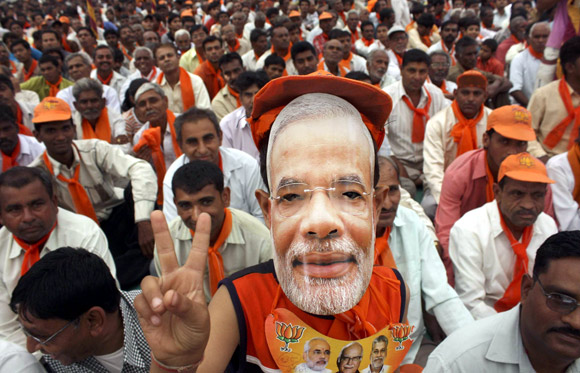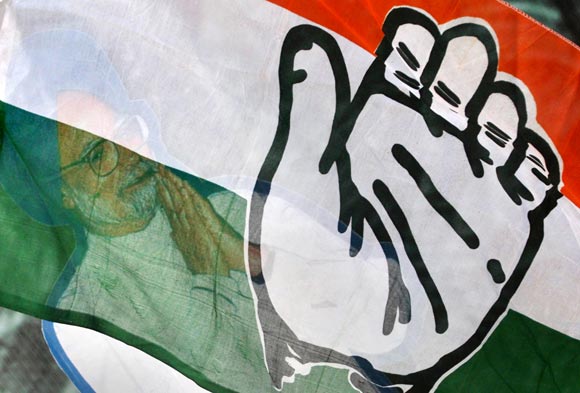 | « Back to article | Print this article |
Modi will have to prove he is a team player
There are enough indications that Gujarat Chief Minister Narendra Modi, with a third term victory behind him, intends to set the pace of events inside the Bharatiya Janata Party at the national level, says Neerja Chowdhury.
A day after his high-profile meeting with the new BJP president Rajnath Singh, senior party leader Yashwant Sinha, who enjoys a sober reputation, took the initiative to urge the party to project Modi as its prime ministerial candidate.
He even went as far as to say that Bihar Chief Minister Nitish Kumar, if he had objections to the idea, could leave the National Democratic Alliance if he so desired.
It is not unusual for the BJP chief ministers to beat a path to the Ashoka Road headquarters of the party to congratulate its new president, and to confabulate with him on organisational challenges and the 2014 elections.
Shivraj Chauhan of Madhya Pradesh has already met with Singh after he took over. So has Karnataka Chief Minister Jagdish Shettar.
Chhattisgarh Chief Minister Raman Singh and Goa Chief Minister Manohar Parrikar are expected to do so in the coming week.
Even though Chouhan and Shettar were ensconced with the new BJP chief for two hours, neither of the meetings made waves. But when it came to Modi, it was a different story. His 135 minute 'heart to heart' with Singh was first lead in papers the next day.
Click NEXT to read further...
Singh will be judged this time around
Given the tension in their relationship during Singh's first tenure as party chief when the Uttar Pradesh leader had tried to keep Modi away from the national scene, this time it is in the interest of both to collaborate.
Singh will be judged this time around by his ability to take everyone along, and be more the party's manager and it will be left to Modi to be the party's face in the elections.
After he met Singh, it was Modi who created ripples with his carefully chosen four sentences: that he had 'elaborately' discussed the 2014 elections with the party chief; that they had talked about all organisational matters; that he had sought Singh's advice on his future ro#8804 and that with Gujarat having scaled new heights, he had asked Singh what it could now do for the whole country.
Singh admitted afterwards that they had discussed a larger role for Modi during their meeting. It is not as if Singh will on his own take a decision whether Modi will head the campaign committee of the party and be part of its parliamentary board, though there is a growing feeling in the higher echelons of the party, that he is their best bet today as a vote getter.
Click NEXT to read further...
The BJP cadre is enthused about Modi
The decision will be taken by the party and its senior leaders, even though Sinha has tried to quicken the process with his 'Modi for PM' salvo on Monday. On his part, Modi used a courtesy call to Singh to his advantage, to step up pressure and stay at the centre of the news, which he is adept at doing.
The process of bringing Modi to the fore was expected to take two to three months, with senior party leaders talking about a 'May (2013) to May (2014)' campaign led by him. In recent months, Modi has crossed many a hurdle in his proposed journey from Gandhinagar to Delhi. Corporate India is clearly rooting for him.
The Western capitals are shedding their reservations about him because of his 2002 role.
The Rashtriya Swayamsevak Sangh brass has come around to accepting him as the only card the BJP can play today, giving up their earlier opposition to him because of his penchant for becoming larger than the party or the Sangh family. The BJP cadre is enthused about him.
But he has many more obstacles to cross. He has to moderate his image not just outside the party but also inside it -- and make himself acceptable to the senior leaders in the party, to come across as a'non-confrontationist', and to convince the party brass that he can be a team player.
Click NEXT to read further...
Cong will stand to gain from a polarisation
His call on Singh was an attempt to mend fences with the new party chief. When the RSS brass had zeroed in on former BJP chief Nitin Gadkari as party president for a second term, Modi went along with it, even though he had had a problematic relationship with 'NG'.
When the search was on for 'who, if not Gadkari', he kept himself scrupulously aloof and neutral, indicating his willingness to accept whoever the party chose.
The irony of the present situation, as it is unfolding, is that Modi and the BJP will have everything to gain from keeping the focus of their campaign around corruption and governance, while holding out the leadership of Modi, as someone with a tough and 'doer' image and his ability to deliver.
It is the Congress which will stand to gain from a polarisation, though it would tread carefully and not like to be seen to be bringing it about for fear of losing the votes of the majority community.
Yet another irony of the situation is that the Congress party, even if it manages to get 150 seats in the next Lok Sabha, may be better placed to form a government, with others, than the BJP with, say, 180. Modi will have to take the BJP tally to 200 to become a player himself.
TOP photo features of the week
Click on MORE to see another set of PHOTO features...




